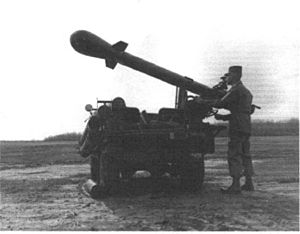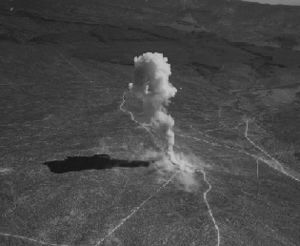Little Feller (nuclear tests) facts for kids
Little Feller II and Little Feller I were special names for a series of nuclear tests. The United States conducted these tests at the Nevada Test Site in 1962. They were part of a larger project called Operation Sunbeam.
Both tests used a type of nuclear weapon called the W54 warhead. This was the smallest nuclear warhead the United States ever made. It was used in devices like the Davy Crockett and the Special Atomic Demolition Munition.
Contents
What Were Little Feller I and II?
Little Feller II Explained
The Little Feller II test happened on July 7, 1962. For this test, the nuclear warhead was placed very close to the ground. It was only about three feet above the surface. The power of its explosion was very small for a nuclear weapon. It was equal to about 22 tons of TNT.
Little Feller I Explained
The Little Feller I test took place on July 17, 1962. This test was different. The warhead was launched from a special launcher. It was a 155 millimeter launcher, like a large cannon. The warhead was part of a Davy Crockett device.
The weapon was set to explode in the air. It detonated between 20 and 40 feet above the ground. This happened about 1.7 miles away from where it was launched. The explosion had a power equal to about 18 tons of TNT.
Important people watched this test. These included Robert F. Kennedy, who was the Attorney General. General Maxwell D. Taylor, a presidential adviser, also observed. The test was done during a simulated military exercise called Operation Ivy Flats.
The End of Above-Ground Tests
Little Feller I is important for another reason. It was the very last time the United States exploded a nuclear weapon near the ground in the atmosphere. Later tests, like the Fishbowl series, happened much higher in the sky. Those high-altitude tests finished in November 1962.
After Little Feller I, all future nuclear tests by the United States went underground. This change happened because of the Partial Test Ban Treaty. This treaty was an agreement to stop nuclear explosions in the atmosphere, underwater, and in outer space.
There was another series of tests called Operation Roller Coaster. These tests did not involve true nuclear explosions. However, they did spread radioactive material using regular explosives. Some people consider these to be the last above-ground nuclear tests.



